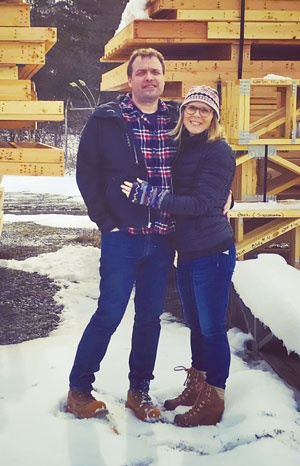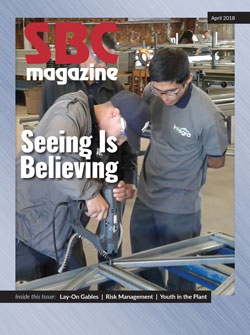Faces of the Industry: Taft & Colleen Ketchum
Faces of the Industry: Taft & Colleen Ketchum
 PDJ Components, Chester, New York
PDJ Components, Chester, New YorkHow’d you get into this industry?
Taft: My grandfather built a truss plant in 1972 (they actually started manufacturing trusses in 1969), and it’s just gone from grandfather, to father and mother, to me. I worked in the shop through high school and through college, and I’ve always been a part of it. I think there was a time where I was going to be a lawyer, and then there was another time I was going to be a teacher, and then there was a short time where I was a landscaper. My father came to me and said he was having problems with his general manager. He flew out to [where Colleen and I were living in] Colorado and said, ‘”hey, do you want to do this?”
Colleen: I think we we’re both thinking it would be nice to move back to the East Coast, so the timing was right. My family was in Connecticut and his was in New York. I was a research scientist and had started my own fitness business, so I was always on the periphery of the truss business, but when we started talking about purchasing the business from Sid…well, it was kind of all-in. We knew it would be “all hands on deck,” still a small family business. So I sold my fitness business, and my focus is a lot on PDJ.
Colleen, where have you found the biggest learning curve as you’ve gotten to know PDJ in particular and the truss manufacturing industry in general?
It is a totally different industry! There were a lot of things that were like, “whoa, ok, that’s how you do things here.” There’s rough outlines of steps to be taken if something happens, but there’s so much unpredictability. For example, weather: that’s something that, in the past, I’d never really thought of as a business consideration; something like a rainy day or snow or extreme heat or extreme cold. Suddenly that becomes a significant hurdle. For instance, if trucks can’t go out because the DOT says trucks can’t be out because of potentially hazardous weather. So, shuffling things around, directing tasks or redirecting work efforts – it’s a lot of on-the-fly management. When something breaks down – a truck or a piece of equipment – management conditions instantaneously change. For example, when it’s super cold. We’re happy, thinking we had a chance to catch up, but then it’s hard to catch up when it’s minus 20. Human power slows down at that temperature!
Taft, have you found any learning curves as you’ve gotten back into truss manufacturing?
When I used to work down in the shop it was…I don’t want to say it was simpler, but it was all gable ends and 500 of these and 200 of those. And now everything’s a one-off custom job. The effort that has to go in on the design end of it has changed tremendously to manufacture the final product. Maybe mass customization is the way it is with the evolution and sophistication of every manufacturing industry, but it just seems with the truss industry that the scope of work requirements continually change. When I first started, if it was too difficult to truss it, you stick framed it. Now, if it’s too difficult to stick frame it, you call the truss guy.
What is the benefit of having the perspective of someone with experience outside of the industry who is now involved in day-to-day operations?
It’s nice. It gives us a fresh view on the business and requires us to look at everything we do more closely. There are times when we’re blind to something and it goes right over our heads because we consider it the norm. Colleen can bring us all back to where you see what needs to change because it’s right in front of your face.
Generational turnover in the family business is something that a lot of component manufacturing companies have dealt with, are dealing with, or are going to deal with soon. What have you learned and what advice do you have?
The hardest part is twofold: it’s keeping things professional and business-like, and maintaining family relations. It’s borderline impossible but, case in point, you can manage it well and get through it! It is more difficult because usually when you are in a typical business deal, you know everybody is negotiating for what’s best for them; but when you get into a family deal, you want what’s best for the other party as well. That’s a difficult line to walk.
I’ve been pretty lucky coming in at this point, with Sid and Taft, because if something comes up, there’s multiple times a day when the three of us sit down and talk about how to solve problems. Those lines of communication stay open, and that’s important because otherwise it would be not fun! Every single day is a challenge and something new. When I come in, I always have something new thrown at me to research, to work through, to work around – and I feel it’s never the same day to day. We have a good balance: I prefer to do more of the putting the fires out…
I don’t!
If it were the same every day, it would be boring.
What’s PDJ focused on right now?
We have some big things going on in the Orange County area here. The LEGOLAND was just approved in Goshen, the next town over. A significant number of jobs will be added in the Orange County area as well as a need for additional housing and general growth in the area from businesses, restaurants, hotels. When was the last time we heard that? Ten or twelve new hotel sites along this fairly short corridor between Chester and Monroe? So there’s a lot of activity happening, plus there’s a town near us in Monroe, where the civic community has formed their own town and what was the approved building?
1400 units.
When you add all the proposed units together, it’ up over 2000. There are hundreds of homes going in. That’s the trajectory of the moment.
[At PDJ,] we’re continuing with our safety program and looking to roll out the SBCA safety program this year. We’ve increased the number of employees here. We brought in a number of additional new hires this year just to meet the demands of the orders that we have, and we’re always looking to expand into new areas and find new revenue streams. We have a couple of things that will hopefully come together by the next time we talk!
What challenges do you see for the industry in the future, and what should SBCA be working on now to meet those challenges?
The thing that pops in the top of my head is just the continuation of automation, the relationship with the equipment manufacturers, and the affordability and accessibility that improves the manufacturing process.
The most important thing is getting fresh minds involved in the industry. The guys that we see year in and year out, I know they’re working hard to get some younger people in, and you just got to keep at it. That’s how the industry’s going to continue on.
Manpower – people power – it’s just been a huge struggle. And that’s why I feel that automation will help manufacturers move the industry forward. So our children, who could one day take over the business, might actually be interested in taking over the business. I think they see how difficult it is to keep staff on board in the current environment. Everything from the cost of healthcare to getting people interested in the manual labor potion of it – it’s hard work! Finding people who are willing to put that physical work in…I think our kids see how much of a challenge it is for Taft and I and their grandfather to keep the plant staffed and happy and to keep people working. So I do see automation as key, even though I’d hate to lose jobs.
Keep in mind, they get repurposed. If we had automation, I don’t know that we would have fewer people. We would have fewer worries about staffing.
And more reasonable hours. And having the quality of life for our employees as well. They do work hard.
Colleen, you’re a member of the SBCA Safety Committee. Any updates?
We’ve been talking about a number of really neat things. One is just to try to get some consistency in the truss industry itself for safety procedures and protocols, so new truss companies coming in and new companies who want to jump in on SBCA’s safety program have an even more expanded set of resources, with more toolbox talks and a step-by-step guide.
When you’re not thinking about trusses, what keeps you busy?
Children.
And sports. Kids and sports. Our hopes and dreams are to someday have a really, super nice van and we’re going to drive places. A tricked out motor home van, and we can visit the national parks. That’s what we’re going to do.
That’s our goal. #lifegoals, right there. We do spend a lot of time on the lacrosse field. We have two high school kids who play year round and a third grader who plays a good portion of the year, so we definitely are on the lacrosse field in one way, shape or form in most of our down time. And we’re savoring it, because we know it won’t last forever.

